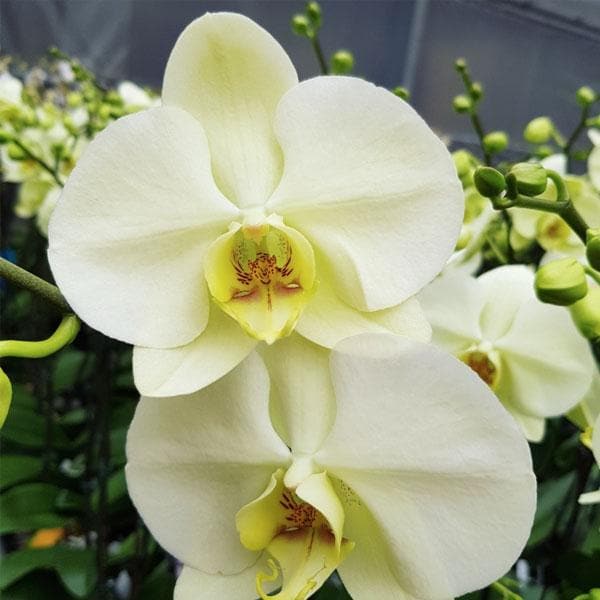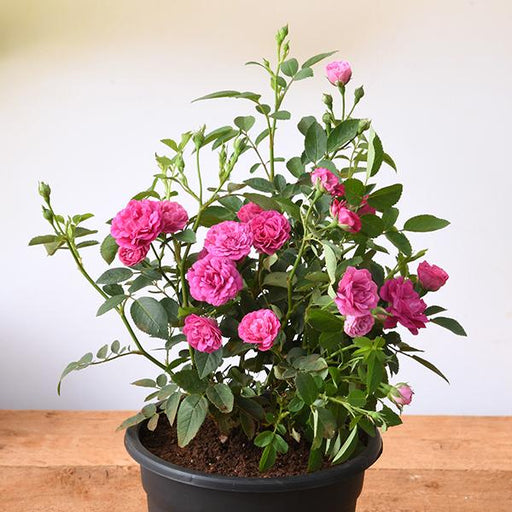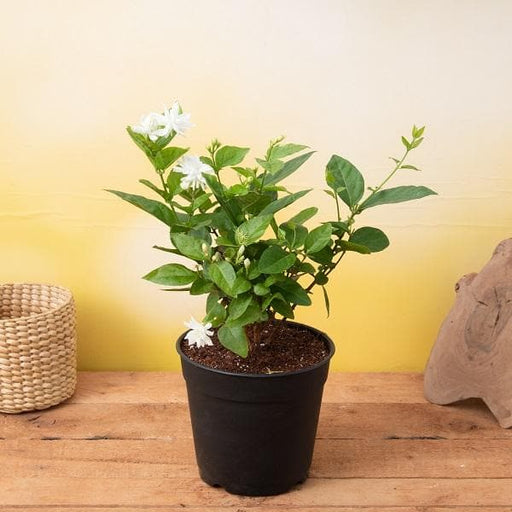
Phalaenopsis Orchid, Yellow - Plant
(MRP Inclusive of all taxes)
- Shipping ₹79 for entire order
- Dispatch in 7 days
- Country of origin: India

(MRP Inclusive of all taxes)
 Save 29%
Save 29%
Air Purifier Money Plant with Pot The Air Purifier Money Plant, also known as Pothos or Epipremnum aureum, is a stunning indoor plant that...
View full details
 Save up to 15%
Save up to 15%
Peace Lily, Spathiphyllum - Plant The Peace Lily, scientifically known as Spathiphyllum, is a stunning houseplant celebrated for its elegant white...
View full details
 Save 25%
Save 25%
Jasminum sambac, Mogra, Arabian Jasmine - Plant Jasminum sambac, commonly known as Mogra or Arabian Jasmine, is a fragrant flowering plant...
View full details
 Save 18%
Save 18%
Combo Constituents Includes the Parijat Tree (Night-Flowering Jasmine), a culturally significant plant with fragrant flowers. Description The Pari...
View full details
 Save 25%
Save 25%
Miniature Rose, Button Rose (Any Color) - Plant The Miniature Rose, also known as the Button Rose, is a charming and compact flowering plant that ...
View full details Save 25%
Save 25%
Damascus Rose, Scented Rose (Any Color) - Plant The Damascus Rose, also known as Rosa damascena, is a timeless symbol of beauty and romanc...
View full details
 Save 17%
Save 17%
Beautiful Fragrant Mogra, Arabian Jasmine Plant with Pot The Beautiful Fragrant Mogra, also known as Arabian Jasmine (Jasminum sambac), is...
View full details Save 15%
Save 15%
Pack of Vermicompost and Neem Cake for House Plants Transform your indoor garden with our premium Pack of Vermicompost and Neem Cake, spec...
View full details
Pack of Plant Growth and Flower Boosters Unlock the full potential of your garden with our Pack of Plant Growth and Flower Boosters! This ...
View full details Save 38%
Save 38%
Combo of Jeevamrut and Neem Raksha for Easy Growth and Protection of Houseplants Transform your indoor garden with our exclusive combo of ...
View full details Save 22%
Save 22%
Plant Nutrients Kit (Pack of 16) for a Healthy Garden Transform your garden into a lush paradise with our Plant Nutrients Kit, featuring 1...
View full details Save 16%
Save 16%
Combo of Top Plant Fertilizers Elevate your gardening game with our exclusive Combo of Top Plant Fertilizers, featuring two bags of premiu...
View full details Save 24%
Save 24%
Pack of 4 Additives to Make Soil Healthy and Nutrient Rich Transform your garden into a thriving ecosystem with our Pack of 4 Additives de...
View full details Save 30%
Save 30%
Transform your gardening experience with our premium Combo of Perlite and Vermiculite. This unique blend is designed to enhance soil aeration and ...
View full details Save 27%
Save 27%
Combo of 2 Vermicompost and Cocopeat - Enrich Your Soil Naturally! Transform your garden into a thriving ecosystem with our Combo of 2 Ver...
View full details
 Save 35%
Save 35%
Best 6 Plants for Perfect Indoor Garden Transform your living space into a lush oasis with our curated collection of the Best 6 Plants for a...
View full details
 Save up to 50%
Save up to 50%
Mini Succulent Garden Pack Transform your space with our Mini Succulent Garden Pack, featuring a delightful collection of 4 any variety beautiful s...
View full details
 Save 30%
Save 30%
5 Best Fragrant Plants Transform your garden or indoor space into a fragrant paradise with our curated selection of the 5 Best Fragrant Plants. Th...
View full details
 Save 24%
Save 24%
Set of 2 Bonsai Looking Grafted Adeniums Transform your indoor or outdoor space with our exquisite Set of 2 Bonsai Looking Grafted Adenium...
View full details Save 45%
Save 45%
Top 4 Die Hard Succulents Pack Transform your indoor or outdoor space with our Top 4 Die Hard Succulents Pack, featuring a curated selecti...
View full details
 Save 30%
Save 30%
5 Best Indoor Plants Pack Transform your living space into a lush oasis with our '5 Best Indoor Plants Pack.' This carefully curated collection fe...
View full details
 Save 25%
Save 25%
Set of 4 Evergreen Air Purifier Plant Pack Transform your indoor space into a lush, green oasis with our Set of 4 Evergreen Air Purifier Pla...
View full details| SrNo | Item Name | Qty |
|---|---|---|
| 1 | Phalaenopsis Orchid, Yellow Plant in 6 inch (15 cm) Pot | 1 |
The Phalaenopsis Orchid, commonly known as the Moth Orchid, is a stunning tropical plant that captivates with its vibrant yellow blooms. This perennial beauty is native to Southeast Asia and is renowned for its long-lasting flowers that can bloom for several months. With its elegant arching stems and glossy leaves, the yellow Phalaenopsis adds a touch of sophistication to any indoor space.
What makes the yellow Phalaenopsis Orchid truly special is its ability to thrive in various indoor conditions, making it a favorite among both novice and experienced plant enthusiasts. Its striking yellow petals symbolize friendship and joy, making it a perfect gift for loved ones. This orchid not only enhances your home decor but also purifies the air, contributing positively to your indoor environment.
Special features of the Phalaenopsis Orchid include its unique ability to bloom multiple times a year, provided it receives the right care. Additionally, its flowers can last up to three months, making it a long-lasting addition to your plant collection. With proper attention, this orchid can become a cherished centerpiece in your home.
Caring for your yellow Phalaenopsis Orchid is like nurturing a diva; it requires just the right amount of attention, light, and humidity. These beauties thrive in bright, indirect sunlight and prefer to be watered when their potting medium is dry. Overwatering is a cardinal sin in the orchid world, so channel your inner Goldilocks and find that perfect balance. With a little love and the right conditions, your orchid will reward you with stunning blooms that will make your friends green with envy.
When it comes to yellow orchids, the Phalaenopsis is the star of the show, but it’s not alone in the spotlight. Other yellow varieties, like the Cattleya and Dendrobium, also bring their own flair to the floral fiesta. Each type has its unique charm and personality, making them perfect companions for your Phalaenopsis. So, why not create a vibrant orchid family that will have your home looking like a tropical paradise?
Choosing the right potting mix for your yellow Phalaenopsis Orchid is crucial. Think of it as picking the perfect outfit for a first date; you want something that looks good but also feels comfortable. A mix of bark, sphagnum moss, and perlite provides excellent drainage and aeration, ensuring your orchid’s roots are happy and healthy. Avoid traditional soil, as it can suffocate your plant faster than a bad pickup line.
Feeding your yellow Phalaenopsis Orchid is like giving it a gourmet meal; it needs the right nutrients to thrive. A balanced orchid fertilizer, preferably one with a higher nitrogen content, will keep your plant blooming like a superstar. Just remember to follow the instructions—overdoing it can lead to a case of the “too much of a good thing” syndrome, which is never a good look for your orchid.
Light is the lifeblood of your yellow Phalaenopsis Orchid, but it’s a bit of a diva when it comes to its preferences. It loves bright, indirect sunlight, so placing it near a window with sheer curtains is ideal. Too much direct sunlight can scorch those delicate leaves, while too little can leave it feeling gloomy. Think of it as finding the perfect spot for a sunbather—just the right amount of warmth without the risk of a sunburn.
Your yellow Phalaenopsis Orchid is a tropical plant at heart, and it craves humidity like a beachgoer craves a cool drink on a hot day. Ideally, humidity levels should be around 50-70%. If your home is drier than a desert, consider using a humidity tray or a humidifier. Just don’t go overboard; you’re not trying to create a rainforest in your living room, just a cozy little oasis for your orchid.
Repotting your yellow Phalaenopsis Orchid is like giving it a fresh start in life. It’s best done every couple of years or when the potting mix breaks down. Choose a pot that’s just a tad larger than the current one, and make sure it has drainage holes—no one likes soggy feet! Gently remove the old mix, trim any dead roots, and place your orchid in its new home. It’s a makeover that will have your plant feeling fabulous.
The blooming season for your yellow Phalaenopsis Orchid is like the grand finale of a fireworks show—spectacular and worth the wait. Typically, these orchids bloom in the winter or early spring, producing stunning flowers that can last for months. With the right care, you’ll be treated to a floral display that will have your guests oohing and aahing. Just remember, patience is key; good things come to those who wait.
Just like any diva, your yellow Phalaenopsis Orchid can attract unwanted attention from pests. Aphids, mealybugs, and spider mites are the usual suspects, and they can wreak havoc if left unchecked. Regularly inspect your plant and treat any infestations promptly with insecticidal soap or neem oil. Think of it as a security detail for your orchid—keeping those pesky intruders at bay so your plant can shine.
Want to expand your orchid family? Propagating your yellow Phalaenopsis Orchid is like starting a new chapter in your plant-parenting journey. While it’s not the easiest task, it can be done through keikis—those adorable little offshoots that pop up on the flower spike. Once they develop roots, you can gently separate them and pot them up. It’s a rewarding process that will have you feeling like a proud parent of multiple orchids.
Just like humans, orchids can fall ill, and your yellow Phalaenopsis is no exception. Fungal and bacterial infections can sneak in if conditions aren’t just right. Keep an eye out for yellowing leaves or unusual spots, and act fast if you notice anything amiss. A little preventive care, like proper watering and good air circulation, can go a long way in keeping your orchid healthy and thriving. After all, a happy orchid is a blooming orchid!
A Phalaenopsis Orchid, Yellow is a stunning tropical plant known for its vibrant yellow blooms. Often called the "moth orchid," it’s a favorite among plant lovers for its long-lasting flowers and easy care. With its elegant appearance, it’s like the diva of the plant world, demanding attention and admiration!
Caring for your Yellow Phalaenopsis Orchid is a breeze! Place it in bright, indirect light, water it every week, and let it dry out between waterings. Think of it as a high-maintenance friend who just needs a little love and attention to thrive. Remember, no direct sunlight—this diva prefers a soft glow!
Water your Yellow Phalaenopsis Orchid about once a week, but check the potting medium first. If it’s still damp, hold off on the H2O. Overwatering is like giving a diva too much attention—sometimes, less is more! Ensure good drainage to keep those roots happy and healthy.
A chunky orchid mix is the way to go for your Yellow Phalaenopsis Orchid. Look for a blend of bark, perlite, and charcoal. This mix provides excellent drainage and aeration, allowing those roots to breathe. Think of it as a luxurious spa treatment for your plant—because every diva deserves the best!
Fertilize your Yellow Phalaenopsis Orchid every two weeks during the growing season with a balanced orchid fertilizer. Dilute it to half strength, because nobody likes a heavy-handed approach! It’s like giving your plant a gourmet meal—just the right amount keeps it blooming beautifully without overwhelming its delicate palate.
Your Yellow Phalaenopsis Orchid typically blooms once a year, but with the right care, it might surprise you with a second show! Patience is key—think of it as waiting for the next season of your favorite show. With proper light and care, those gorgeous yellow flowers will grace your space in no time!
The blooms on a Yellow Phalaenopsis Orchid can last anywhere from two to three months! That’s a long time for a plant to flaunt its fabulousness. Just remember, once the flowers start to fade, it’s not a breakup—it’s just a seasonal change. New blooms will come to take their place!
Absolutely! Propagating your Yellow Phalaenopsis Orchid is like creating mini-divas. You can do this through keikis, which are baby plants that grow on the flower spike. Wait until they have roots, then gently separate them. It’s a rewarding process, and soon you’ll have a whole entourage of orchids!
Keep an eye out for pesky pests like aphids, mealybugs, and spider mites. They’re the uninvited guests at your orchid’s party! If you spot them, a gentle wash with soapy water or insecticidal soap will send them packing. Your orchid deserves a pest-free environment to shine!
Good news for pet parents! The Yellow Phalaenopsis Orchid is non-toxic to cats and dogs. So, let your furry friends roam freely around your plant without fear. Just remember, while it’s safe, it’s still a plant—so keep an eye on curious nibblers who might think it’s a salad!
Your Yellow Phalaenopsis Orchid loves a cozy environment! Aim for temperatures between 65°F to 75°F during the day and a bit cooler at night. It’s like finding the perfect temperature for a cozy blanket—just right! Avoid extreme temperature swings, as this diva prefers a stable climate to thrive.